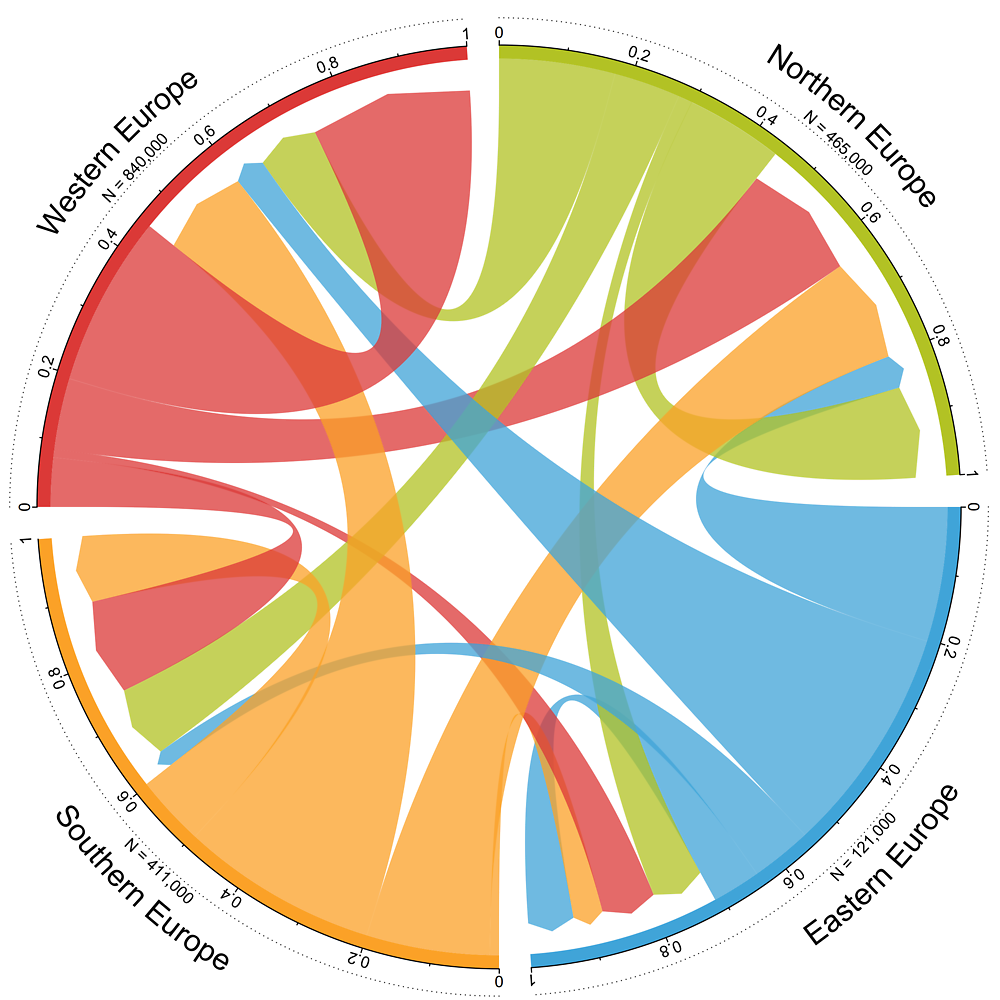Arbeitsbereich
Migration und Mobilität
Auf einen Blick
Projekte
Publikationen
Team
Projekt
Die Untersuchung internationaler Migration hoch-qualifizierter Fachkräfte mit Hilfe umfangreicher digitaler Spuren
Daniela Perrotta, Elizabeth Marie Jacobs, Tom Theile, André Grow-Böser, Emilio Zagheni; in Zusammenarbeit mit Sarah Charlotte Johnson (MPIDR), Carlos Callejo Penalba (Aalto University, Finnland), Kiran Garimella (Rutgers, The State University of New Jersey, New Brunswick, Vereinigte Staaten), Ingmar Weber (Saarland University, Saarbrücken, Deutschland), Helga de Valk (Netherlands Interdisciplinary Demographic Institute / University of Groningen, Niederlande)
Ausführliche Beschreibung
High-skilled migration represents an important and increasingly large component of international migration, with substantial socioeconomic implications for sending and receiving countries. Standard data on migration are often costly, coarse-grained, and inconsistent across countries. Alternative data and methods thus are needed to routinely capture the ever-growing and ever-changing phenomenon of high-skilled migration and to provide a clearer picture of the spatiotemporal and sociodemographic aspects of the international migration of professionals. Digital trace data from social media implicitly provide rich information, which can be exploited to identify mobility patterns in unprecedented ways.
In this project, we retrieve digital trace data from the social networking service LinkedIn to capture the migration dynamics of professionals across Europe and the globe. The aim is to leverage LinkedIn data to study high-skilled migration and complement traditional data sources. We focus on professional migration to new destination countries and on return migration, a research area that is often understudied due to data limitations. We also develop mobility models to assess the extent to which there are imbalances in migration flows based on sociodemographic characteristics, such as gender or field of occupation.
We exploit two sources within LinkedIn: the Recruiter platform and the Advertising platform. LinkedIn Recruiter enables recruiters from subscribing companies to identify potential job candidates through user profile attributes such as industry, educational attainment, and years of experience. We are particularly interested in the ability to search the Recruiter platform for users open to job-related relocation to a prospective location that differs from where they currently work. In recent research, we have demonstrated the utility and limitations of leveraging LinkedIn Recruiter data as a proxy for migration aspirations of professionals in Europe (Perrotta et al. 2022). We have shown how the relative attractiveness between European countries can be modeled with a gravity-type approach and identified regions that are particularly attractive, beyond what would be predicted by the variables included in a gravity model.
The LinkedIn Advertising platform provides an estimate of LinkedIn users who meet specific targeting criteria, such as gender, age group, and industry. We leverage this feature to measure the number of high-skilled LinkedIn users who moved from their country of study to their current country of work in Europe, across different groups determined by age, gender, and sector. This will allow us to characterize differentials in mobility patterns of LinkedIn users by sociodemographic and occupational characteristics, and it will open up new opportunities for inference to be made on the general population of high-skilled workers in Europe.
LinkedIn data provide high spatiotemporal data resolution and insights that are difficult to obtain from traditional data collection schemes. However, this does not come without challenges because digital data are generally characterized by systematic biases, such as self-selection and measurement biases. LinkedIn users include a sizable fraction of high-skilled workers but are not representative of the general population of high-skilled workers. As we refine our approaches to evaluate the causes and consequences of high-skilled migration, we also plan to develop methods to identify the type of information that can be reliably extracted from users of LinkedIn and other platforms, and to eventually provide generalizations that go beyond the specific platform.
Offenheit für berufsbedingte Umzüge zwischen europäischen Regionen

Chord diagram of the numbers of LinkedIn users open to relocation between two countries, aggregated to European regions. Direction is indicated by arrowhead and size by the width at the base of the arrow. Proportions have been scaled within each region. © Perrotta, D., S.C. Johnson, T. Theile, A. Grow-Böser, H. De Valk and E. Zagheni (2022). Openness to migrate internationally for a job: evidence from LinkedIn data in Europe. In: Proceedings of the Sixteenth International AAAI Conference on Web and Social Media (ICWSM-22): Atlanta, Georgia and online, June 6th - 9th, 2022; hybrid conference, 759–769. Palo Alto, CA: AAAI Press. (2022)
Migration, Wirtschaft, Erwerbstätigkeit, Ruhestand
Publikationen
Jacobs, E. M.; Theile, T.; Perrotta, D.; Zhao, X.; Anastasiadou, A.; Zagheni, E.:
Population and Development Review, 1–32. (2025)

Jacobs, E. M.:
Social Forces, 1–22. (2024)

Jacobs, E. M.:
Journal of Ethnic and Migration Studies, 1–25. (2024)
Jacobs, E. M.; Theile, T.; Perrotta, D.; Zhao, X.; Anastasiadou, A.; Zagheni, E.:
MPIDR Working Paper WP-2024-037. (2024)

Sîrbu, A.; Goglia, D.; Kim, J.; Magos, Maximilian P.; Pollacci, L.; Spyratos, S.; Rossetti, G.; Iacus , S. M.:
Journal of Computational Social Science, 1–32. (2024)

Coimbra Vieira, C.; Fatehkia, M.; Garimella, K.; Weber, I. G.; Zagheni, E.:
In: Data science for migration and mobility, 141–158. Oxford: Oxford University Press. (2022)
Perrotta, D.; Johnson, S. C.; Theile, T.; Grow, A.; de Valk, H. A. G.; Zagheni, E.:
In: Proceedings of the Sixteenth International AAAI Conference on Web and Social Media (ICWSM-22): Atlanta, Georgia and online, June 6th - 9th, 2022; hybrid conference, 759–769. Palo Alto, CA: AAAI Press. (2022)

Perrotta, D.; Johnson, S. C.; Theile, T.; Grow, A.; de Valk, H. A. G.; Zagheni, E.:
MPIDR Working Paper WP-2022-007. (2022)
